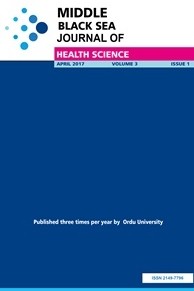Clinical Outcome of Arthroscopic Treatment of Anterior Ankle Pathologies
Objective: The ankles that are the main organs cause standing over the earth can be damaged by different reasons. The ankles become painful with the problems like impingement syndrome that is soft tissue hipertrofies, osteochondral defects that is cartilage damages, traumatic or degenerative arthropaties, intraarticular tumoral tissues and some problems like that. These painful ankles can be treated with conservative methods. If it is impossible to treat painful ankles with conservative way it can be treated by minimal invasive ankle arthroscopy that is cheaper and much more satisfied, of treatment. Methods: We aim to evaluate the results and effectiveness of arthroscopic treatment of the patient who has the forefoot disorders. Also, we hope to compare the advantages, difficulties and probable complications of the arthroscopic treatment according to conservative therapy and to investigate the factors that can effect the clinical results. The 40 patients who were practiced and operated with ankle arthroscopy who was followed at least one year were compared statistically with pre-op and post-op condition. By this way the effectiveness of arthroscopy for the patients who have anterior ankle problems was determined and the main factors that effect the results were investigated. According to the result of statistical analyses preop and postop AOFAS and NPS score avarages were found clear different to each other. Results: The ankle arthroscopy that is practised by experienced surgeons with an appropriate procedure after a good clinical practise and a proper indication causes a high patient satisfaction and it causes less and temporary complications. Because of all these reasons we believe that the ankle arthroscopy can be practised by the appropriate surgeon to the appropriate patient population. Conclusion: We believe that the outcomes of ankle arthroscopy performed properly by experienced hands after determining the patient population who were accurately diagnosed by careful clinical examination and necessary imaging methods are greatly satisfactory, and the acceptability is high thanks to complications being less and usually transient.
Keywords:
ankle arthroscopy, ankle pathologies, anterolateral impingement, osteochondral defect, ankle arthrosis,
___
- Aydin A.T, Gokkus K: Ankle arthroscopy: indication and technique, Journal of TOTBİD; 2013; 12: p. 134-141.
- Aydin AT. Ankle arthroscopy (Indications, diagnostic and surgical arthroscopy), Acta Orthop Traumatol Turc 1996; 30: p. 470-483. Aydin AT, Ankle arthroscopy. In: Aydin AT, Editor. Ankle arthroscopy. Antalya: Orkun Ozan Media Services INC. 2009; p. 42-44.
- Aydin AT. Diagnostic and operative arthroscopy of the ankle. 1 st. Turkish Sports Traumatology, Arthroscopy and Knee Surgery Congress, İstanbul-Turkey:1991, 25-28 . Ferkel RD, Heath DD, Guhl JF. Neurological complications of ankle arthroscopy. Arthroscopy. 1996; 12: p. 200-208.
- Ferkel RD, Small HN, Gittins JE. Complications in foot and ankle arthroscopy. Clin Orthop Relat Res 2001; 391: p. 89–104. Glazebrook MA, Ganapathy V, Bridge MA, Stone JW, Allard JP. Evidence-based indications for ankle arthroscopy. Arthroscopy. 2009; 25: p. 1478-90.
- Lawrence AD, Albert AG. Current concepts in ankle arthroscopy. Podiatry today. 2011; 24(4): p:54-61.
- Pinar H, Aydinok HC, Altunan AK: Arthroscopy of the cadaver ankle. Acta Orthop traum Turcic 1989; 23: p. 317-321.
- Smith TO, Hing CB. The efficacy of the tourniquet in foot and ankle surgery? A systematic review and meta-analysis. Foot Ankle Surg. 2010; 16: p. 3-8.
- Son KH, Cho JH, Lee JW, Kwack KS, Han SH. Is the anterior tibial artery safe during ankle arthroscopy?: Anatomic analysis of the anterior tibial artery at the ankle joint by magnetic resonance imaging. Am J Sports Med 2011; 39: p. 2452– 56
- Tecimer T, Yedek I, Bilgic E, Zaim E, Kılıckap C: Use tourniquet in extremity surgery, Acta Orthop Traumatol Turc 1995; 29: p. 172-176.
- Tosun H.B, Yılmaz E. The Results of microfracture method in the treatment of osteochondral lesions of the talus. Fırat Medical Journal 2009; 14(3): p. 175-180
- Zaidi R, Hasan K, Sharma A, Cullen N, Singh D, Goldberg A. Ankle arthroscopy: a study of tourniquet versus no tourniquet: Foot Ankle Int. 2014; 35: p. 478-82.
- Zengerink M, van Dijk CN. Complications in ankle arthroscopy. Knee Surg Sports Traumatol Arthrosc. 2012; 20: p. 1420-31.
- Yayın Aralığı: Yılda 4 Sayı
- Başlangıç: 2015
- Yayıncı: Ordu Üniversitesi
Sayıdaki Diğer Makaleler
Ferhat AYRANCI, Kadircan KAHVECİ
Mustafa ÇALGIN, Yeliz ÇETİNKOL
Ahmet ÇALIŞKAN, Rıza DURMAZ, Canan ATEŞ GÜRSOY, Nilay ILDIZ
Kutsi TUNCER, Mehmet KÖSE, Murat TOPAL, Eyüp ŞENOCAK, Ömer Selim YILDIRIM
Tuğba Raika KIRAN, Onder OTLU, Ercan KARABULUT, Aysun BAY KARABULUT
Bora ÇOŞKUN, Burcu TİMUR, Buğra ÇOŞKUN, Ferdi KINCI, Coşkun ŞİMŞİR
